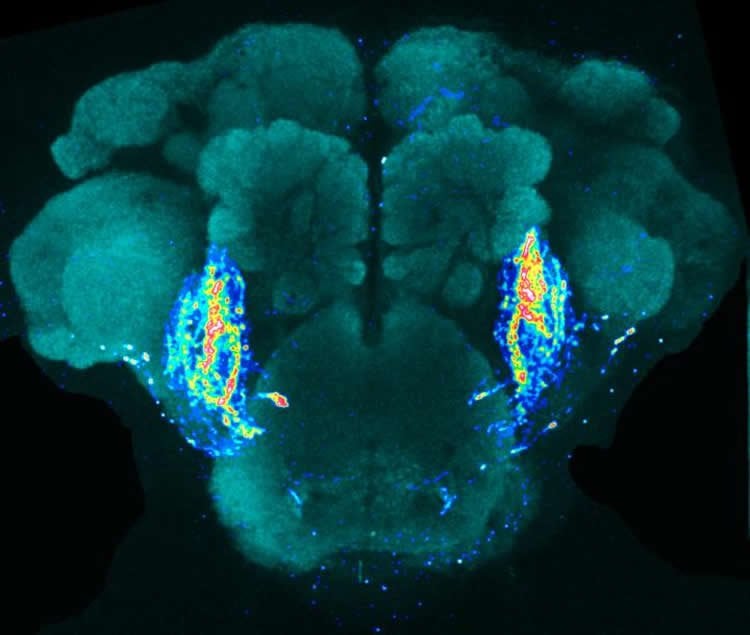New research, published today in eLife, identified the neural circuit in the brain of the fruitfly (Drosophila melanogaster) that is responsible for detecting a taste pheromone, which controls the decision of male flies to mate with females.
In the natural world, sense of taste controls many behavioral decisions. For many animals, pheromones, which are chemical signals used for communication, influence the choice to mate. However, very little is known about how taste pheromones are processed in the brain.
The recent work by Joanne Yew, assistant researcher at the Pacific Biosciences Research Center (PBRC), a newly integrated research unit of the School of Ocean and Earth Science and Technology (SOEST) at the University of Hawai’i – Mānoa, and colleagues explicitly tracked this process – identifying the taste cells on the fruitfly’s legs which detect the pheromone, locating the neurons in the brain which respond to the pheromone, and mapping the connection between the two populations of cells.
The pheromone, named CH503, is produced by males, passed to females during mating, and stops other males from mating with the female – it is an anti-aphrodisiac for other males.
Many taste cells are found on the forelegs of flies, so Yew and colleagues used genetic manipulation to turn off activity in individual classes of these taste cells. They then tested whether males could still respond to the pheromone. Using this strategy, they were able to identify one class of taste receptors, called Gr68a, that is responsible for detecting the pheromone.
“Normally, males are repulsed by females that have been perfumed with the pheromone. However, when activity in Gr68a neurons is turned off, males will actively try to mate with females perfumed with the pheromone,” said Yew.
Next, the researchers turned off activity in different groups of cells in the central brain to determine whether males could still respond to the pheromone. One group of cells which produces the chemical Tachykinin appeared to be essential for detecting the pheromone.

Finally, the scientists established that the Gr68a neurons in the leg connect with the Tachykinin neurons in the brain. To do this, they introduced 2 sensors into the Gr68a and Tachykinin neuron populations. The sensors light up when neurons in the region are close enough to form connections. The researchers were able to detect connectivity between the two populations of neurons.
“This work identifies a molecular signal, Tachykinin, that controls the perception of taste pheromones and provides an anatomical map of where this information is processed in the brain,” said Yew. “By understanding the cellular basis of how taste information is encoded, we will be able to study how sensory signals shape programmed behaviors and influence complex social decisions such as the choice to mate. Potentially, we could devise a way to manipulate Tachykinin in pest populations to control reproduction.”
In the future, Yew and colleagues intend to further map the connections of Tachykinin neurons and examine how physiological state (e.g., hunger, stress) can influence the choice to mate via the Tachykinin pathway.
Source: Marcie Grabowski – University of Hawaii at Manoa
Image Credit: Image credited to Meredith Calvert and Kah Junn Tan.
Original Research: Abstract for “The neuropeptide tachykinin is essential for pheromone detection in a gustatory neural circuit” by Shruti Shankar, Jia Yi Chua, Kah Junn Tan, Meredith EK Calvert, Ruifen Weng, Wan Chin Ng, Kenji Mori, and Joanne Y Yew in eLife. Published online June 17 2015 doi:10.7554/eLife.06914
Abstract
The neuropeptide tachykinin is essential for pheromone detection in a gustatory neural circuit
Gustatory pheromones play an essential role in shaping the behavior of many organisms. However, little is known about the processing of taste pheromones in higher order brain centers. Here, we describe a male-specific gustatory circuit in Drosophila that underlies the detection of the anti-aphrodisiac pheromone (3R,11Z,19Z)-3-acetoxy-11,19-octacosadien-1-ol (CH503). Using behavioral analysis, genetic manipulation, and live calcium imaging, we show that Gr68a-expressing neurons on the forelegs of male flies exhibit a sexually dimorphic physiological response to the pheromone and relay information to the central brain via peptidergic neurons. The release of tachykinin from 8 to 10 cells within the subesophageal zone is required for the pheromone-triggered courtship suppression. Taken together, this work describes a neuropeptide-modulated central brain circuit that underlies the programmed behavioral response to a gustatory sex pheromone. These results will allow further examination of the molecular basis by which innate behaviors are modulated by gustatory cues and physiological state.
“The neuropeptide tachykinin is essential for pheromone detection in a gustatory neural circuit” by Shruti Shankar, Jia Yi Chua, Kah Junn Tan, Meredith EK Calvert, Ruifen Weng, Wan Chin Ng, Kenji Mori, and Joanne Y Yew in eLife. Published online June 17 2015 doi:10.7554/eLife.06914






